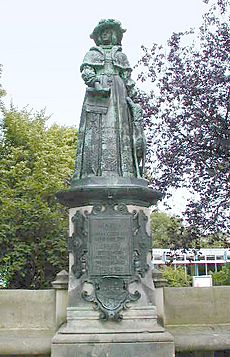Maria of Jever facts for kids
Quick facts for kids
Maria of Jever
|
|
|---|---|

Painting of Miss Maria, 1572
|
|
| Born | 5 September 1500 Jever |
| Died | 20 February 1575 (aged 74) Jever |
| Noble family | Wiemken |
| Father | Edo Wiemken the Younger |
| Mother | Heilwig of Oldenburg |
Maria of Jever, often called Fräulein Maria (which means "Miss Maria") in the Jeverland area, was a very important ruler. She was the last leader of the Lordship of Jever from the Wiemken family. Maria ruled from 1517 until she died in 1575.
Contents
Maria's Early Life
Maria was born on September 5, 1500. She was the third child of Edo Wiemken the Younger, who was a powerful East Frisian chieftain. Her mother was Heilwig, and she was the sister of Count John V of Oldenburg.
Sadly, Maria's mother passed away when Maria was only one year old. About ten years later, her father also died.
Growing Up Without Parents
After her father's death, a group of five village elders took charge. They became the regents (people who rule for a young leader) and guardians of Maria and her siblings. Her brother, Christopher, was given a special education. He was being prepared to become the next Lord of Jeverland. Maria and her two sisters were raised to marry important people. These marriages would help their family's wealth and political power.
Problems with Who Would Rule Next
Something unexpected happened: Lord Christopher died suddenly when he was only 18 years old. This changed everything! Since there was no other male heir (a male family member who could inherit the rule), Maria became the next ruler of Jeverland.
A Tricky Marriage Plan
Edzard I, Count of East Frisia, a powerful neighbor, showed his military strength near the border. With the approval of the regents, he made a marriage contract. This contract made him the "protector" of Jeverland. It seemed Maria would have to marry one of Edzard's sons.
However, the future counts, Enno and John, did not wait for the marriage. They took over Jever Castle in 1527. This was a very humiliating experience for Maria. A local official named Boing of Oldersum, who might have been in love with Maria, drove the invaders out. But he died during a siege (a military blockade) of Wittmund. Maria never married anyone after this.
Becoming the Lady of Jeverland
In 1531, Maria made an unusual choice to protect her rule. She asked for help from Emperor Charles V. This was to make sure her independence was strong against her neighbors. The Emperor, who was also the Count of Holland and Duke of Brabant, took control of Jeverland. Then, he gave it back to Maria as a fief (land given in exchange for loyalty and service).
By doing this, the Emperor protected her right to rule. But Jeverland lost its "imperial immediacy" (meaning it was directly under the Emperor, not a local lord) which it had since 1417. Even so, this decision finally allowed Maria to gain full control over Jever.
Maria's Strong Rule
In the years that followed, Maria successfully defended her family's land. She slowly took full charge of the government. Some historical writings say that her "strong will and growing desire for independence" helped her greatly.
At first, Maria was against the Reformation (a big change in the Christian church). But in 1532, she brought Lutheranism (a branch of Protestantism) to Jever. Maria is remembered as a good ruler who did a lot for her land. She helped trade grow and made sure that justice and law were respected. She also gave Jever city rights in 1536.
Maria also improved her castle. She made her territory bigger by creating new polders (low-lying land reclaimed from the sea) and locks (water gates). These improvements helped agriculture and commerce (trade) to do very well.
In 1556, Maria changed the city church's choir area, which had been damaged. She turned it into a special grave chapel. Between 1561 and 1564, a beautiful Renaissance-style grave monument for her father was built in this chapel. This monument can still be seen today.
Maria's Death
Maria died on February 20, 1575. She had ruled for almost fifty years. Her death was kept a secret at first. This was because people feared that the Counts of East Frisia might try to take power.
Her room was sealed, and food was placed outside her door. A servant is said to have secretly eaten the food. This made it seem like Maria was still alive. This secrecy continued until Maria's rightful heir, Count John VII of Oldenburg, arrived.


